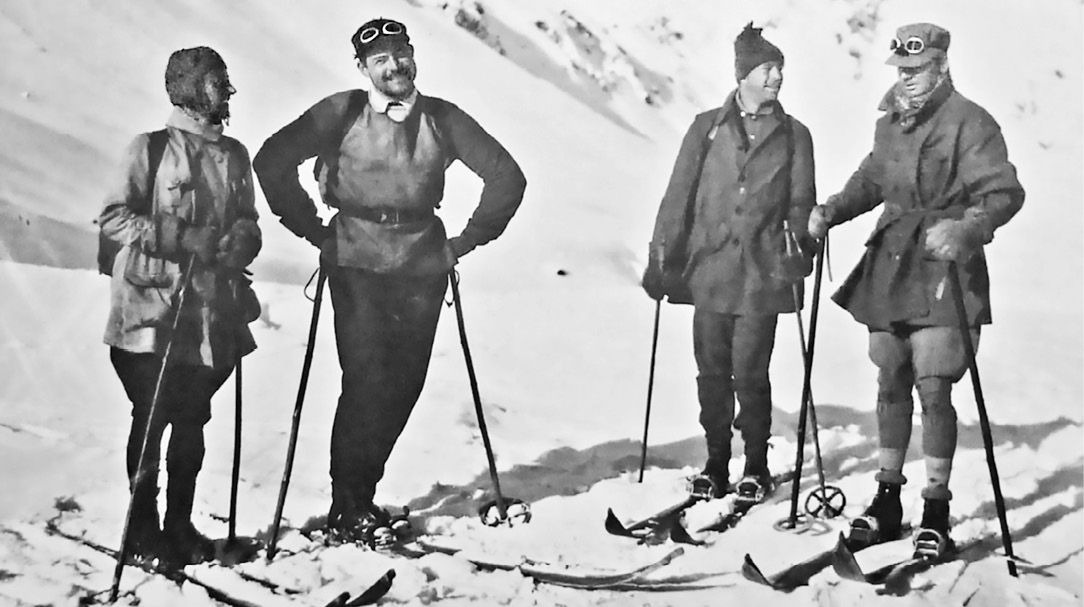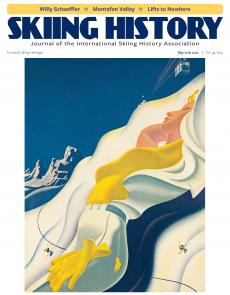SKIING HISTORY
Editor Seth Masia
Managing Editor Greg Ditrinco
Consulting Editor Cindy Hirschfeld
Art Director Edna Baker
Editorial Board
Seth Masia, Chairman
John Allen, Andy Bigford, John Caldwell, Jeremy Davis, Kirby Gilbert, Paul Hooge, Jeff Leich, Bob Soden, Ingrid Wicken
Founding Editors
Morten Lund, Glenn Parkinson
To preserve skiing history and to increase awareness of the sport’s heritage
ISHA Founder
Mason Beekley, 1927–2001
ISHA Board of Directors
Rick Moulton, Chairman
Seth Masia, President
Wini Jones, Vice President
Jeff Blumenfeld, Vice President
John McMurtry, Vice President
Bob Soden (Canada), Treasurer
Richard Allen, Skip Beitzel, Michael Calderone, Dick Cutler, Wendolyn Holland, Ken Hugessen (Canada), David Ingemie, Joe Jay Jalbert, Henri Rivers, Charles Sanders, Einar Sunde, Christof Thöny (Austria), Ivan Wagner (Switzerland)
Presidential Circle
Christin Cooper, Billy Kidd, Jean-Claude Killy, Bode Miller, Doug Pfeiffer, Penny Pitou, Nancy Greene Raine
Executive Director
Janet White
janet@skiinghistory.org
Membership Services
Fawn Montanye
(802) 367-3408
fawn@skiinghistory.org
Corporate Sponsorships
Peter Kirkpatrick
(541) 944-3095
peterk10950@gmail.com
Bimonthly journal and official publication of the International Skiing History Association (ISHA)
Partners: U.S. Ski and Snowboard Hall of Fame | Canadian Ski Museum and Hall of Fame
Alf Engen Ski Museum | North American Snowsports Journalists Association | Swiss Academic Ski Club
Skiing History (USPS No. 16-201, ISSN: 23293659) is published bimonthly by the International Skiing History Association, P.O. Box 1064, Manchester Center, VT 05255.
Periodicals postage paid at Manchester Center, VT and at additional mailing offices. Postmaster: Send address changes to ISHA, P.O. Box 1064, Manchester Center, VT 05255
ISHA is a 501(c)(3) public charity. EIN: 06-1347398
Written permission from the editor is required to reproduce, in any manner, the contents of Skiing History, either in full or in part.
Montafon Valley, Austria
Hemingway's hideaway still makes a fine escape.
In November 1924, a relatively unknown writer named Ernest Hemingway came to Austria’s Montafon Valley at the suggestion of a friend. Hemingway was living in Paris at the time, on a shoestring, and the friend assured him that this cozy, snowy Alpine valley near the Swiss border was an affordable paradise. Hemingway clearly agreed. With his wife and young son, he stayed the entire winter, and then the next.
(Photo above: Left to right, Sara Murphy, Hemingway, John Dos Passos and Gerald Murphy, touring above Schruns. Hemingway sought solitude in order to finish his breakthrough novel, The Sun Also Rises.)
Nearly a century later, an even-less-known writer and her husband came to the Montafon at the suggestion of a friend, seeking a similar escape. As it did then, the valley delivered.
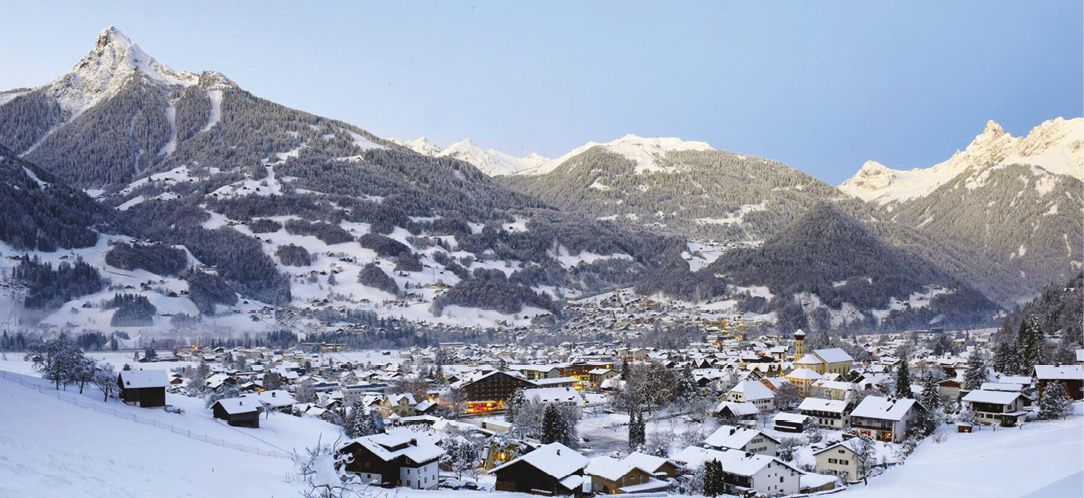
My friend Mo discovered the Montafon about a decade ago, after an expensive and unsatisfying ski vacation at a big Western resort. Since then, he’s been back—winter and summer—at least once every year, with some or all of his family. After years of hearing his sales pitches, and eager for some European travel, my husband and I committed to the journey.
It was not my first visit to the Montafon. I had vague memories of racing a World Cup there in 1992, and, after the two-hour drive from Zurich, I recognized the cobblestoned Kirchplatz of Schruns. The 39-kilometer-long (23.4 miles) Montafon Valley—bound on the north by the Verwall Alps and by the Silvretta and Rätikon mountain ranges to the south—extends from the outskirts of Bludenz past Schruns, the valley’s main village, to the tiny village at the Partenen, where we stayed.
The Vorarlberg (literally “before Arlberg”) is a part of Austria that’s often overlooked by skiers who head to the better-known resorts on the eastern side of the Arlberg Tunnel in Tirol. Even to Austrians, the Vorarlberg often feels more Swiss than Austrian, and the heavy, musical dialect reflects that. After World War I, the region even tried unsuccessfully to become part of Switzerland.
For some history of skiing in the valley, I stopped by the Montafoner Museum in Schruns, where historian and author Dr. Andreas Brugger is an archivist and resident expert. Within moments of our meeting, he delved into the extensive rows of floor-to-ceiling archives and retrieved full documentation of my participation in the 1992 World Cup on the Golmer Joch, which was the last major international Alpine competition in the valley.
FIRST SKIING
Winter sports clubs started in the Montafon in 1906, first in Schruns and two months later in adjacent Tschagguns (the area is also referred to as Schruns-Tschagguns). Though initially the main activity was toboganning, in 1910 the area hosted the first Vorarlberg state championships in downhill skiing on the Golmer Joch, on the northwestern end of the valley.
Ski development stopped during World War I, though soldiers still trained to ski in the valley. During the interwar period, skiing boomed, as it did throughout the Alps. Starting in 1919, as villages throughout the valley established their own winter sports clubs, skiing overtook tobogganing in popularity. During this period, Hemingway installed himself at the Hotel Taube for $2 a day, writing in the early mornings before climbing up the mountains with sealskins on the bottom of his skis to race downhill on runs like the Silvretta, the Versettla and the Kapell, then drinking kirsch schnapps and playing poker into the evening.
The area hosted the Vorarlberg state championships again in 1933, with competitions in downhill skiing, cross-country skiing and jumping; meanwhile, ski jumps were built in
Tschagguns. Just as ski-sport development was taking off, World War II again stalled it.
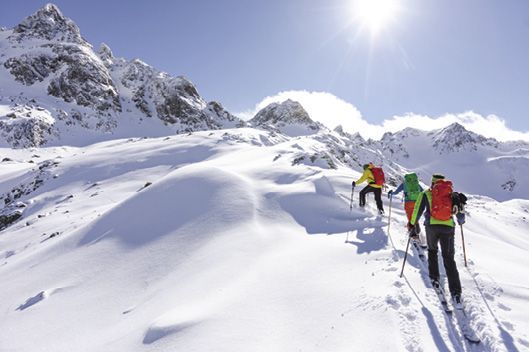
touring trails, crossing into Switzerland.
Stefan Kothner, Montafon Skiturismus
Gargellen, tucked up another valley in the Montafon’s southwest area, was a well-established smugglers’ path. The (Swiss) Silvretta and (Austrian) Rätikon ranges, explained Brugger, “were a mountain border between war and peace twice.” Beginning in the 18th century, locals maintained a vigorous smuggling trade via rough trails over the ridge to Switzerland, which had neither a road nor an official border crossing. During World War II, locals helped shuttle people escaping Nazi persecution, including Jews, political refugees and draft dodgers. At the end of the war, Nazis allegedly escaped via the same route. Those smuggling trails are now summer hiking routes, and in winter Gargellen is a popular jumping-off point for cross-border ski tours to Switzerland.
Skiing enjoyed its second heyday after the war. Schruns-Tschagguns again hosted the Vorarlberg state championships in 1946 and the first Austrian post-war Alpine and Nordic championships in 1947. For these events local clubs built Vorarlberg’s first chairlift, and a new combined ski jump that hosted Austria’s first night event in the sport.
During this time the area was occupied by the French army and under strict food rations. Racers, officials and press were treated to extra food procured on the black market, earning the area the reputation as Austria’s “Golden West.” By 1949, in order to cooperate on building facilities and hosting events, the various clubs started associating as the Ski Club Montafon, Events included the “Two Piste” races in the 1950s, where men and women sped down a pair of descents—the Kapell, from Hochjoch to Schruns, and the Hartmann, from Grabs to Tschagguns.
By 1960, Ski Club Montafon included all nine clubs from valley towns: Schruns, Tschagguns, Vandans, St. Gallenkirch, Gaschurn, Partenen and Bartholomäberg as well as the side valleys of Silbertal to the north and Gargellen to the south. A successful era of cross-country skiing also started in Gaschurn, and by 1977 locals had garnered 10 national titles.
From 1963 to ’83, Ski Club Montafon drew top women to the Montafon Gold Key Races. Starting in 1967, the Gold Key was a regular stop on the women’s World Cup circuit. When a blizzard struck in 1983, 18 teams left town in spite of the jury’s decision to hold the downhill. The local club suffered a major financial loss and ended the Gold Key series. The area hosted one final Women’s World Cup in 1992, where hometown hero and 1988 Olympic gold medalist Anita Wachter competed on the course named for her.
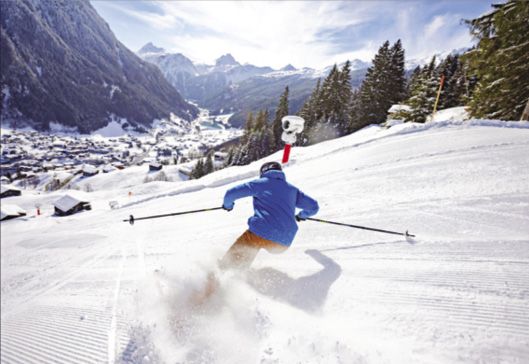
areas in Austria. Stefan Kothner photo.
Savoring the Slopes
Our friend Mo wanted to show us all of the Montafon, and we tried our best to comply, falling into the easy routine of a European skiing vacation. Each day started with the dreamy Austrian buffet breakfast at the Hotel Sonne, complete with fresh semmels, cheeses, meats, muesli, yogurt, fruit and carafes of strong coffee and hot milk. From there we headed across the street to catch a quick bus ride down to Gaschurn, where we could hop on the Versettla Bahn up the western side of the valley or, just down the road, St. Gallenkirch and the ultra-modern Silvretta complex, where gondolas went up the Valisera to the west or the Hochjoch to the east. At the Silvretta base are retail and rental shops and a ski testing center, plus a market hall with restaurants and cafés serving local specialties. Beneath it is the largest e-charging garage in Vorarlberg. The development is just one example of the Montafon’s resort investments, aimed at modernizing rather than expanding.
The Silvretta Nova side, above St. Gallenkirch and Gaschurn, features a massive variety of steep frontside and backside terrain, while the expansive Hochjoch, above Schruns and Silbertal, includes the Montafon Snow Park, whch hosts the annual World Cup snowboard events. From the top of the Hochjoch, we skied back to Schruns via the Hochjoch Totale, a 12-kilometer (7.2 miles ), 1,700-meter (5,600 feet) descent. If you hit the gas, the run feels like the ultimate citizen super-G.
In 2008 Silvretta Nova and Hochjoch merged as the Silvretta Montafon, including Golm and Gargellen, to become one of Austria’s 10 largest ski areas. With a weekly ticket that works out to some $50 a day, it doesn’t take much wind in the face to get your money’s worth. By the time we stopped for lunch at one of the modern mountain-top lodges or, even better, gathered around the stammtisch (the table for local regulars) at a cozy hut for coffee and schnapps, homemade soup and apfel strudel, we were usually ready to call it a day. Later on, dinner at the hotel, included in the room rate, was dependably delicious.
A highlight for any skier is the Silvretta Ski Safari. It starts from Partnenen with a tram ride up the Vermunt Bahn, then a white-knuckle bus ride through two tunnels to the Bielerhöhe Pass, which connects Vorarlberg to Tirol. (In summer this area is accessible by the Silvretta-Hochalpenstraße, home of an annual vintage car rally. From Partenen the road rises 700 meters [2,300 feet] over three kilometers [1.8 miles] with 25 hairpin turns, then mellows to its high point on the Silvretta reservoir.) From the pass, the ski safari follows the gentle descent of the summer road; at the bottom, snowcats pull skiers across a snowfield to Galtür. The route then loops back to Partenen.
We were disappointed to find the trek closed due to avalanche hazard, so we based out of the Berggasthof Piz Buin. Smack on the border of Tirol, this is one of three hotels/huts at the Bielerhöhe Pass. Hemingway roomed in one of the others, the rustic Madlenerhaus, now a base for the German Alpine Club. From there, we skinned up a less hazardous exposure to glimpse the Piz Buin and surrounding 10,000-foot peaks that make this the largest ski touring area in Vorarlberg.
It’s easy see how a soon-to-be-famous writer found the fortitude to rewrite The Sun Also Rises, or call up the vivid imagery in the Snows of Kilimanjaro, or capture the emotion of an era gone by in A Moveable Feast. Hemingway may have moved on to fame and Gstaad, but some of us will be happy to get right back here to the Montafon. 
Regular contributor Edith Thys Morgan wrote about Spider Sabich in the March-April issue.
Table of Contents
WORLD CHAMPIONSHIP ($3,000+)
BerkshireEast/Catamount Mountain Resorts
Gorsuch
Warren and Laurie Miller
Sport Obermeyer
Polartec
CHAMPIONSHIP ($2,000)
Fairbank Group: Bromley, Cranmore, Jiminy Peak
Hickory & Tweed
Rossignol
Snowsports Merchandising Corporation
WORLD CUP ($1,000)
Aspen Skiing Company
Bogner of America
Boyne Resorts
Dale of Norway
Darn Tough Vermont
Dynastar/Lange/Look
Gordini USA Inc/Kombi LTD
Head Wintersports
Intuition Sports
Mammoth Mountain
Marker/Völkl USA
National Ski Areas Association
North Carolina Ski Areas Association
Outdoor Retailer
Ski Area Management
Ski Country Sports
Sports Specialists Ltd
Sugar Mountain Resort
Sun Valley Resort
Vintage Ski World
World Cup Supply
GOLD MEDAL ($700)
Larson's Ski & Sports
Race Place/Beast Tuning Tools
The Ski Company (Rochester NY)
Thule
SILVER MEDAL ($500)
Alta Ski Area
Boden Architecture PLLC
Dalbello Sports
Deer Valley
EcoSign Mountain Resort Planners
Elan
Fera International
Holiday Valley Resort
Hotronic USA/Wintersteiger
Kulkea
Leki
Masterfit Enterprises
McWhorter Driscoll LLC
Metropolitan New York Ski Council
Mt. Bachelor
New Jersey Ski & Snowboard Council
Nils
Russell Mace Vacation Homes
SchoellerTextil
Scott Sports
Seirus Innovations
SeniorsSkiing.com
Ski Utah
Snowbird Ski & Summer Resort
Steamboat Ski & Resort Corp
Sundance Mountain Resort
Swiss Academic Ski Club
Tecnica Group USA
Timberline Lodge and Ski Area
Trapp Family Lodge
Wendolyn Holland
Western Winter Sports Reps Association
World Pro Ski Tour
Yellowstone Club

